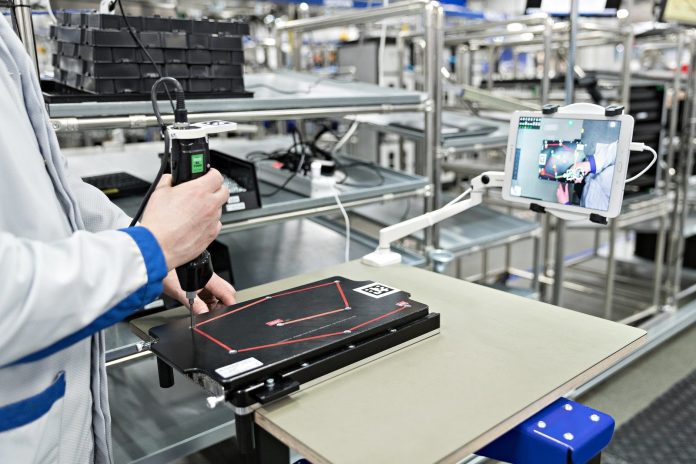Note, this article is continued from a previous post, entitled ‘Industrial companies are building private networks because they have to, says Nokia’. Click here to go to the previous article.
Where were we? Oh yes: part-way through a narrative about the desire of industry to make mobile networks private, with or without their traditional operators; settled on an analogy about an open door and a storm outside.
Mobile connectivity which can be trusted for critical operations – which will peak with ultra-reliable low-latency communications (URLLC), as prescribed in 3GPP’s Release 16 specifications for 5G NR – promises a networking springboard for the intelligence and innovation that might just transform industry.
As Vodafone said in these pages last week, 5G puts operators, public or private, in charge of a control network for the first time, rather than just a voice-and-data network. In industry, control is everything, and there is money to be made in the supply and management of these new wireless control networks.
Nokia is in for their supply, and will assist in their management, as requested. But the operator community, in charge of public networks for three decades or more, could be in the cold – as enterprises become their own network operators.
The winds of change are blowing, and the door is swinging open, and yet the operator community can’t make the threshold. Even if operators get past the doorway, they could be effectively shut out by the control freaks of industry. Because it is about control, after all, and this is their manor; they want to keep charge.

“Especially if it is mission or business critical,” reasons Richard Kitts, vice president of enterprise and IoT services at Nokia. “Even if the operator can provide the solution, the customer may want to have control of it.”
The rush to bring higher-grade connectivity and intelligence to industrial operations has already started. Operators only just defining their Industry 4.0 strategies are late, already. Serious-minded enterprises will not wait, when networking gear is readily available and easily deployable, and spectrum is coming available.
“They will use whatever spectrum they can get,” comments Kitts. In the US, the Federal Communications Commission has released the country’s 3.5 GHz (Band 48) frequencies – a 150MHz wide chunk of prime mid-range spectrum, previously reserved for the ‘citizens broadband’ radio service (CBRS) – for private and shared usage.
The MulteFire Alliance, which includes Nokia and Ericsson, has standardised LTE for usage in the global 5 GHz band. Its new 1.1 spec adds spectrum bands (2.4 GHz and sub-1GHz spectrum, plus the 1.9 GHz DECT band in Japan), as well as low-power wide-area (LPWA) capabilities to ape LTE-M and NB-IoT.
But MulteFire may yet become redundant as the industry starts to standardise LTE and 5G for unlicensed spectrum anyway. At the back-end of 2018, a new 3GPP work item proposed a pathway to make cellular technologies work in the unlicensed 5 GHz and 6 GHz bands.
The question of how the telecoms community will coexist with the industrial set around the fringes of these new private networks was written into the subtext of MWC 2019, the big operator trade show, last month.
It appears like governments, regulators, and industries are already moving on vacant spectrum. In the Netherlands, ports are already making private use of Band 41/42 (3400-3600 MHz) spectrum for LTE set-ups to control cranes and automated guided vehicles, as well as low-level LTE-based tracking.

Germany’s Federal Network Agency has just confirmed it will award spectrum for the provision of local 5G services in the second half of this year. German companies will be able to apply for spectrum in the 3.7-3.8 GHz band. So-called ‘C-Band’ spectrum as low as 3.4 GHz will be auctioned for 5G. Siemens et al are in the wings.
What about Nokia, in all of this? Behind a vast stand showing its Industry 4.0 credentials at MWC 2019, we put the question to Kitts. How many private LTE networks has it deployed for industry so far, roughly? “The pipeline is significant,” he says. What about deployments? Ten, 50, 100? “It is not 10, and it is not 50.”
Because private LTE was a feature of many of the industrial demos and proofs at this show 12 months ago. MulteFire, which Nokia has played a key role to develop, has been available for some months, CBRS is geared-up in the US, and various regulators in Europe are prepping their industries. Is 2019 the year of private LTE, finally, even as non-standalone 5G networks roll out?
“Yes, now it is really taking off. It is hard to keep up with demand,” says Kitts. With private networks, is there a sense yet of how much will go through licensed and unlicensed spectrum? “I don’t know”. However, private LTE running in unlicensed spectrum will bring its own momentum, he says.
“It will unlock a lot of activity”.
What about slicing, where public network coverage is available? Does slicing preclude the need for private LTE in unlicensed spectrum? “That is a big opportunity. But it comes back to whether operators are enterprise-focused, and what enterprises want – a slice of someone else’s network from someone else, or control of their own?”
But are private networks and public slices complementary, actually? “I think so – they can be very complementary.”
So Aston Martin, say (our conversation has touched on its work with mixed reality), could run a private LTE network from Siemens, say (Enterprise IoT Insights has just returned from Erlangen), and take a slice from a Vodafone 5G network, say (next on the MWC interview schedule), for high-end robotics at the same time?
“Why not? I mean, you make the business case for both. You’ll probably find it’s a bit like with edge and cloud computing – that they segment what they do based on the physicality of the operations, and could use one to backup the other. It’s all still a network, right?”
It’s a neat place to stop, which describes a future scenario of hybrid cellular networks for industry, where no one is left out – where the door swings open to reap the whirlwind of industrial change. “It won’t be one way or another, this or that,” says Kitts. “Over time, we will see this kind of hybrid infrastructure evolve.”
Industrial companies are building private networks because they have to, says Nokia
Private networks and public slices will combine in hybrid industrial 5G, says Nokia

